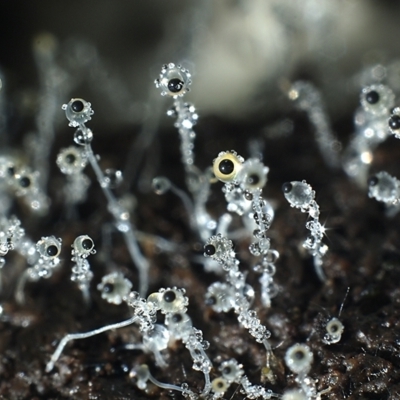Pilobolus crystallinus
The fruitbody consists of a black 'egg' (a sporangium) that sits atop the swollen end (a vesicle) of a clear stem. The fruitbody is reported to grow to well over a centimetre tall, but often is much shorter. The sporangium is up to about a half millimetre in diameter. In fresh fruitbodies, you see water droplets on the stem.
The species is found worldwide and the fruitbodies appear on the dung of many herbivore species (and there have been a few reports from non-herbivore dung).
Look-alikes
Other species of Pilobolus are very similar and for identification you may need to look at sporangial shape, the base of the stem or spore shape/size. There is also some resemblance to Pilaira, but in that genus there is no vesicle below the sporangium.
The sporangium
The sporangium contains spores within the firm black casing and at maturity it is shot off and, ideally, comes to land on a grass blade that will be eaten by a herbivore (and the spores are deposited with the dung dropped by the herbivore). Greaves (see below) writes: "The final requirement is that the sporangia stay on the grass and do not drop too low to be eaten. This is accomplished by a small amount of the mucus from the vesicle being fired with the sporangium thus creating a sticky pad. To back this up, the top surface of the sporangium is hydrophobic ensuring that if it happens to land in a drop of dew on the grass it will rotate to allow the sticky pad to take hold".
Reference
Greaves, M. (2014). Pilobolus in Britain, Field Mycology, 15, 62-64.
Pilobolus crystallinus is listed in the following regions:
Canberra & Southern Tablelands
Species information
- Pilobolus crystallinus Scientific name
- Common name
- Not Sensitive
- Cosmopolitan
- Non-invasive or negligible
- Machine learning






